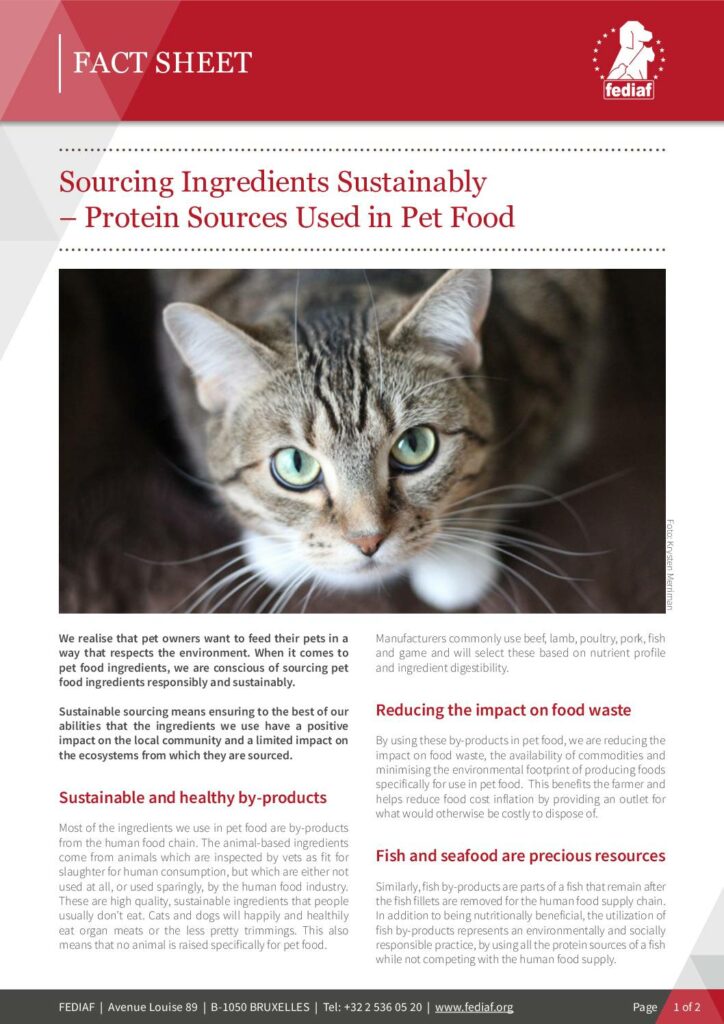We realise that pet owners want to feed their pets in a way that respects the environment. When it comes to pet food ingredients, we are conscious of sourcing pet food ingredients responsibly and sustainably. Sustainable sourcing means ensuring to the best of our abilities that the ingredients we use have a positive impact on the local community and a limited impact on the ecosystems from which they are sourced.
Sustainable and healthy by-products
Most of the ingredients we use in pet food are by-products from the human food chain. The animal-based ingredients come from animals which are inspected by vets as fit for slaughter for human consumption, but which are either not used at all, or used sparingly, by the human food industry. These are high quality, sustainable ingredients that people usually don’t eat. Cats and dogs will happily and healthily eat organ meats or the less pretty trimmings. This also means that no animal is raised specifically for pet food.
Manufacturers commonly use beef, lamb, poultry, pork, fish and game and will select these based on nutrient profile and ingredient digestibility.
Reducing the impact on food waste
By using these by-products in pet food, we are reducing the impact on food waste, the availability of commodities and minimising the environmental footprint of producing foods specifically for use in pet food. This benefits the farmer and helps reduce food cost inflation by providing an outlet for
what would otherwise be costly to dispose of.
Fish and seafood are precious resources
Similarly, fish by-products are parts of a fish that remain after the fish fillets are removed for the human food supply chain. In addition to being nutritionally beneficial, the utilization of fish by-products represents an environmentally and socially responsible practice, by using all the protein sources of a fish while not competing with the human food supply.
Overfishing is a key challenge facing all of us in the human and pet food sector, replacing vulnerable species with more sustainable species or alternative proteins is another change many manufacturers continue to adopt and explore.
Increasing demand for animal-based protein
The human population is expected to grow to ten billion by 2050 and assuming consumption habits continue as they currently are, this is expected to increase global demand for animal-derived protein.
Pet food producers are now working to address the anticipated gap between available meat-based proteins for pet food and the projected demand. Research and development centred on new approaches is crucial to address the issue of sustainability and, as ever, there must be no compromise in nutritional quality to ensure pets receive a healthy and balanced diet.
Alternative protein sources
Insect protein is very much talked about with a protein content between 40 and 75% depending on the species; some pet food brands now include an insect protein source.
There is much research into protein rich meat alternatives such as “cultured” or “in vitro meat”, soy-based tofu or seitan from wheat gluten.
Algae protein also has great potential, it has almost double the protein content of beef, grows ten times faster than terrestrial plants – and absorbs CO2 as an additional sustainability effect.
On-going research and innovation will provide alternative protein sources for human and pet foods – our role as pet food industry will be to transform these into palatable and nutritious pet foods.
Low impact on food waste
Currently the industry has a low impact on food waste, with less than 1%1 of pet food thrown away by consumers compared to an average of 30% of all other food purchases.
Committed to looking at solutions to minimise environmental impact
As the pet food industry, we are proud of the steps already taken in reducing waste in the food chain and minimising its overall impact on the environment. As the squeeze on resources and food availability continues, we are committed to looking at further solutions to minimise the environmental impact and sustainable use of resources in the manufacturing of pet food.
Download the factsheet or click here for more factsheets.
1 Source WRAP Reports
